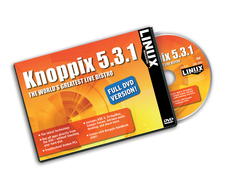Knoppix 5.3.1
Knoppix 5.3.1

Knoppix is the quintessential Live troubleshooting tool for admins, developers, and desktop Linux users. This Debian-based distro runs directly from the DVD drive on a variety of Intel-based systems. Version 5.3 adds new features, such as VirtualBox virtualization and the Compiz-Fusion window manager. Knoppix offers an impressive collection of GNU/Linux software, as well as automatic hardware detection and support for a variety of graphic cards, sound cards, and USB devices. We are happy to bring you Knoppix 5.3.1 as this month's Linux Magazine DVD.
The phenomenon of the Live distro is sweeping the world of Linux. Just place the DVD in the tray and run the whole operating system from the removable disc – without disturbing the contents of the hard drive. Knoppix creator Klaus Knopper pioneered many of the techniques used today in other Live distros, and Knoppix remains at the forefront of the Live Linux movement.
Knoppix offers a powerful collection of troubleshooting and diagnostic tools for professional sys admins, who use it to test for problems and resurrect downed computers. But Knoppix is also a powerful desktop system, built with ingenious compression features to deliver more business applications and user tools than you would ever expect to find on a bootable DVD.
[...]
Buy this article as PDF
(incl. VAT)
Buy Linux Magazine
Subscribe to our Linux Newsletters
Find Linux and Open Source Jobs
Subscribe to our ADMIN Newsletters
Support Our Work
Linux Magazine content is made possible with support from readers like you. Please consider contributing when you’ve found an article to be beneficial.

News
-
Zorin OS 18 Hits over a Million Downloads
If you doubt Linux isn't gaining popularity, you only have to look at Zorin OS's download numbers.
-
TUXEDO Computers Scraps Snapdragon X1E-Based Laptop
Due to issues with a Snapdragon CPU, TUXEDO Computers has cancelled its plans to release a laptop based on this elite hardware.
-
Debian Unleashes Debian Libre Live
Debian Libre Live keeps your machine free of proprietary software.
-
Valve Announces Pending Release of Steam Machine
Shout it to the heavens: Steam Machine, powered by Linux, is set to arrive in 2026.
-
Happy Birthday, ADMIN Magazine!
ADMIN is celebrating its 15th anniversary with issue #90.
-
Another Linux Malware Discovered
Russian hackers use Hyper-V to hide malware within Linux virtual machines.
-
TUXEDO Computers Announces a New InfinityBook
TUXEDO Computers is at it again with a new InfinityBook that will meet your professional and gaming needs.
-
SUSE Dives into the Agentic AI Pool
SUSE becomes the first open source company to adopt agentic AI with SUSE Enterprise Linux 16.
-
Linux Now Runs Most Windows Games
The latest data shows that nearly 90 percent of Windows games can be played on Linux.
-
Fedora 43 Has Finally Landed
The Fedora Linux developers have announced their latest release, Fedora 43.

